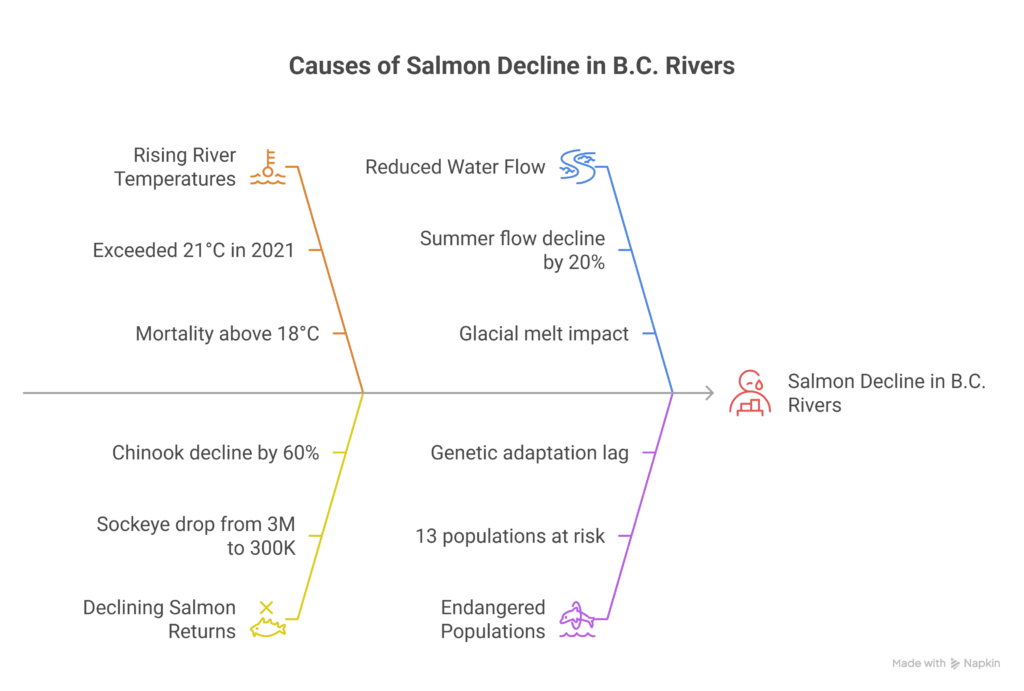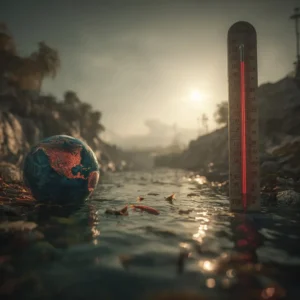Wild Pacific salmon are a cornerstone of Canada’s coastal ecosystems, Indigenous cultures, and local economies—especially in British Columbia. But these iconic fish are now swimming against a powerful new current: climate change.
Rising ocean temperatures, extreme weather events, shifting river flows, and habitat loss are dramatically affecting salmon at every stage of their life cycle. The result? Fewer fish, smaller runs, and more pressure on already vulnerable species.
Let’s dive into the hard facts.
🔥 Warming Waters Are Deadly for Salmon
Pacific salmon species like sockeye, coho, pink, and chinook are cold-water fish that thrive in temperatures between 12°C and 14°C. But summer temperatures in some B.C. rivers have already exceeded 20°C, creating deadly conditions for migrating salmon.
- In 2021, the “heat dome” that blanketed British Columbia caused temperatures in the Fraser River to rise above 21°C, leading to mass die-offs during the salmon run.
- According to the Pacific Salmon Foundation, salmon experience stress, reduced swimming ability, and increased mortality at temperatures above 18°C.
💧 Glacial Melt and Droughts Alter River Flows
Climate change is causing glaciers to melt earlier in the season and droughts to become more severe, resulting in lower river flows during the critical salmon migration period.
- The Fraser River, one of Canada’s most important salmon-spawning rivers, has seen declines in summer water flows of up to 20% in some years.
- Low water levels and warmer temperatures can delay salmon migration or trap them in small pools, increasing the risk of predation and disease.
🐟 Drastic Declines in Wild Salmon Returns
Salmon returns have been plummeting over the past several decades. While overfishing and habitat degradation have contributed, climate change is now a major force behind these declines.
- In 2022, only 300,000 sockeye salmon returned to the Fraser River—a sharp drop from over 3 million in the early 1990s.
- Chinook salmon populations have declined by more than 60% in some B.C. rivers over the past 30 years.
- The Committee on the Status of Endangered Wildlife in Canada (COSEWIC) now lists 13 Pacific salmon populations as endangered, threatened, or of special concern.
🌊 Ocean Conditions Are Becoming Less Hospitable
Salmon spend most of their adult lives in the ocean, and warming seas are disrupting the entire food web.
- The 2014–2016 Pacific marine heatwave, known as “The Blob,” reduced plankton and forage fish—critical salmon food sources—and resulted in weaker, smaller salmon returns.
- Warmer ocean waters also shift salmon distribution northward, causing competition with other species and disrupting migration timing.
🧬 Genetic Adaptation Can’t Keep Up
While salmon have evolved to adapt to changing environments over millennia, the pace of climate change is too fast.
- Studies show that genetic adaptation for temperature tolerance in Pacific salmon could take hundreds of years—far too slow to keep up with warming trends occurring over mere decades.
🧊 What Can Be Done?
Protecting salmon requires urgent, climate-focused action:
- Habitat restoration and reforestation to cool rivers
- Upgraded fish passages and dam removal projects
- Stronger fisheries management and climate-informed policies
- Reducing emissions to slow global warming
Here are some quick stats
- 🌡 Fraser River temperatures exceeded 21°C in 2021
- 🐟 Sockeye returns dropped from 3 million (1990s) to 300,000 (2022)
- 💧 Summer water flow in Fraser River declined by up to 20%
- ⚠️ 13 Pacific salmon populations are now endangered, threatened, or of special concern
- 🔥 Salmon mortality increases above 18°C
- 📉 Chinook salmon declined by over 60% in some B.C. rivers

🌱 Final Thoughts
Pacific salmon are a powerful symbol of resilience, but they’re now swimming upstream against an overwhelming force. If we want to protect these vital species—for our environment, food systems, and future generations—we need to act now.
Climate change isn’t just a future problem for salmon. It’s already here

